Troubleshoot the PingID desktop app
The PingID desktop app does not open
If the PingID desktop app does not open:
-
Check for a running instance of the PingID desktop app and terminate it.
-
Windows: Go to Task Manager → Processes, locate the PingID process, and click End Task.
-
Mac: Go to Apple Menu → Force Quit Applications.
-
-
Restart the PingID desktop app.
The PingID desktop app one-time passcode (OTP) is rejected by the authentication screen
If the OTP generated by the PingID desktop app is rejected by the authentication screen:
-
In the PingID desktop app, click Refresh.
-
Copy the new OTP to the clipboard.
-
Go to the authentication page in the browser and paste the new OTP, or enter it manually.
-
If the problem persists, contact your administrator or support team.
When adding a new device, the PingID desktop app does not appear as an authentication method
If the available authentication methods do not include the PingID desktop app, contact your system administrator or support desk. The organization’s security policy might not approve usage of the PingID desktop app for authentication.
Unable to install the PingID desktop app
The installer wizard window does not appear when the installer is activated, and it appears as though the wizard cannot run. This might be caused by:
- Missing administrator privileges on the machine
-
Contact your organization’s system administrator to update permissions, or to implement the installation.
- Antivirus software blocking the PingID desktop app installation without alerting or reporting it
-
The following scenario occurred on a Windows 10 PC running Avast antivirus. There was no response when launching the PingID desktop app installer and no alert. The following steps resolved this issue:
-
Temporarily disabling the antivirus to permit normal installation of the PingID desktop app.
-
Determining whether an antivirus update was available. The antivirus indicated
Everything up to date. Further investigation revealed that although the engine and database were up to date, a newer release of the program was available. -
After updating the program and launching the PingID installer, the antivirus alerted that it was running a 15-second check for malware. After that check, the PingID desktop app installation proceeded normally.
-
The PingID desktop app does not launch on Mac after the installation of custom fonts
If the PingID desktop app does not launch on a Mac after custom fonts are installed:
-
Open the Font Book application.
-
Go to Menu → File → Restore Standard Fonts.
-
Run the PingID desktop app. It should now launch successfully.
-
Close the PingID desktop app.
-
Reinstall the custom fonts.
-
Run the PingID desktop app again. If it does not launch successfully, repeat steps 1-3.
There is a new requirement to create a PIN on the PingID desktop app
Previously, when the PingID desktop app was launched or accessed, the OTP screen was immediately visible. Now the desktop app opens with a prompt to create a PIN.
This is the result of an organizational security policy decision to secure the desktop app with either a 4 or 6-digit PIN.
Users can choose the PIN codes to use for desktop app access. Follow the instructions on the desktop app screen to create the PIN.
|
PingID enforces a PIN numbering policy that rejects repeated or consecutive numbering patterns. |
The PingID desktop app displays the message "PIN too simple"
When creating a PIN for the first time, or when changing the PIN, the PingID desktop app rejects the entry and displays PIN too simple.
Create PIN example
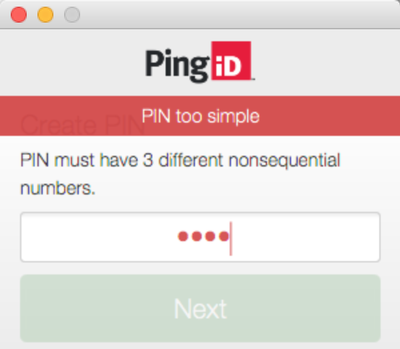
Change PIN example
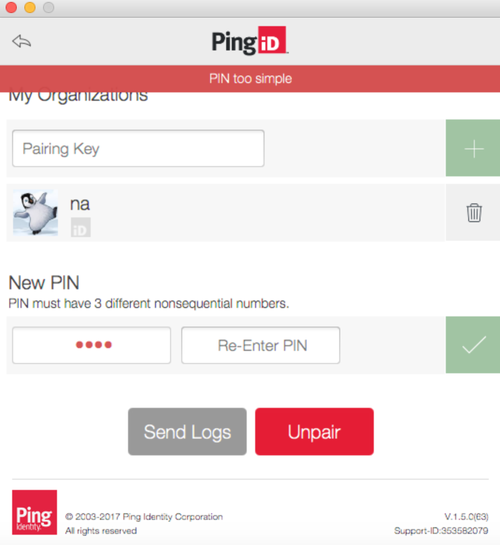
PingID enforces a PIN numbering policy that will reject repeated or consecutive numbering patterns. Choose a new PIN with a more random sequence of digits.
The PingID desktop app displays the Locked screen, although the PIN was entered earlier
Although the correct PIN was entered earlier in the day, or even few minutes earlier, the desktop app now displays the Locked screen.
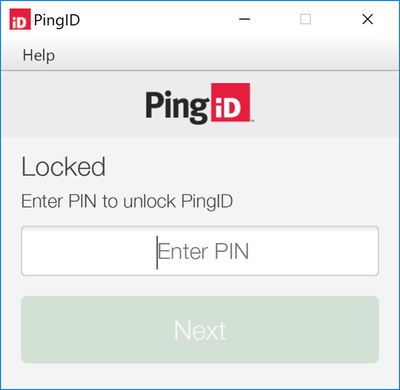
This is the normal behavior when the PingID desktop app is secured with a PIN code. After 3 minutes of inactivity on the desktop app, the app reverts to the Locked screen and prompts for PIN input. Enter the PIN to gain access to the OTP screen.
The PingID desktop app displays the message "Incorrect PIN"
After entering the current PIN, either to access the desktop OTP screen or when attempting to change the PIN, the desktop app displays Incorrect PIN.
Enter PIN example

Change PIN example
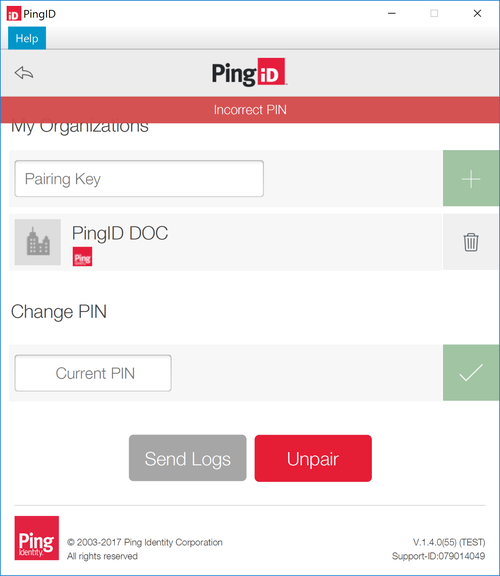
This can result from the following:
-
The PIN entered is incorrect. Check that all the digits are entered in the correct sequence.
-
The PIN is for a different installation of the desktop app or on another machine. Check that the desktop app is accessed from the correct user account on the correct computer.
If the above solutions are not successful, unpair the desktop app and pair it again or contact your administrator or support team.
The PingID desktop app displays the "Blocked" screen
After entering the PIN, either to access the desktop OTP screen or when attempting to change the PIN, the desktop app displays the Blocked screen.
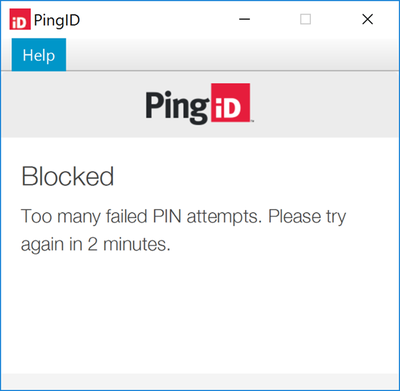
This is the result of entering the PIN incorrectly three consecutive times. The Incorrect PIN message would have been displayed after each of the first two incorrect PIN entries. The desktop app is locked for 2 minutes. Lockdown takes effect from the time of the lock, irrespective of whether the desktop app has remained open or has been closed and relaunched.
After 2 minutes, the app reverts to the Locked screen.
A user forgot the PIN for their PingID desktop app
If a user forgets their desktop app PIN, see Resetting a user’s desktop app PIN.
The PingID desktop app displays the "Device Not Connected" screen
If a user unpairs the desktop app and the Device Not Connected screen is displayed, the user’s computer is in offline mode.
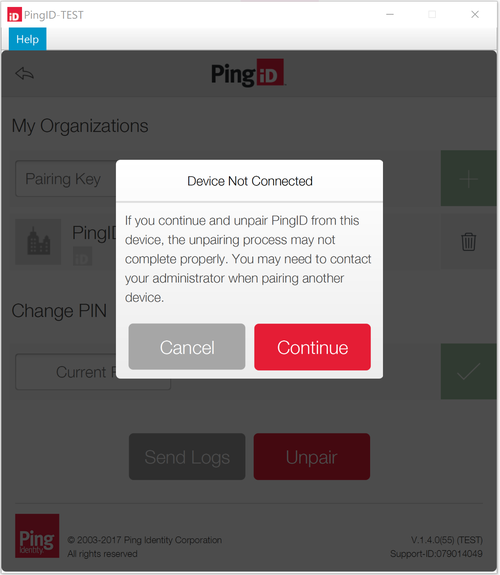
The local desktop app can be successfully unpaired in offline mode, but the entry for the desktop app in PingID’s list of services still exists. This will prevent the user from pairing the desktop app again.
The user must contact the administrator to unpair the desktop app in PingID’s list of services. Alternatively, if the user removes the desktop app from their list of devices, the entry for the desktop app in PingID’s list of services will be unpaired.
The authentication screen prompts for the PingID desktop app OTP, but the PingID desktop app is not paired
If a user has unpaired the desktop app and wants to pair it again, when they launch the app they are prompted to enter a pairing key.
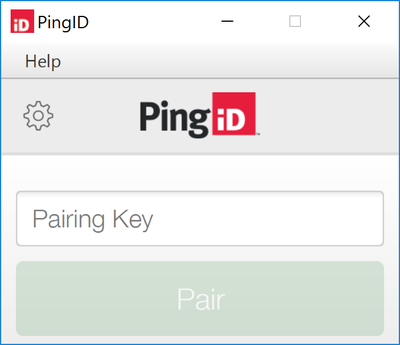
The user then connects to a service protected by PingID, expecting the enrollment screen with the link to an alternate authentication method, from which they could navigate to the desktop setup supplying them with a new pairing key. Instead of the enrollment screen, the authentication screen displays immediately, prompting the user to enter an OTP from the desktop app.
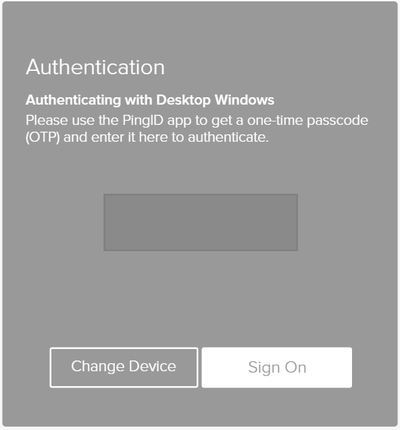
The user cannot provide the OTP because the desktop app is unpaired and is unable to get a pairing key to pair the desktop app.
This can be caused by unpairing the desktop app while in offline mode, leaving the entry for the desktop app intact in PingID’s list of services. Contact the administrator or support team to unpair the desktop app in PingID’s list of services.
When trying to access the PingID desktop app, the user receives the No network connection error
If the user sees the no network connection error when using the PingID desktop app, it might indicate that there is a problem with your connection to the proxy.
-
The user might be signing on to PingID from outside the company network and did not turn off their proxy connection. If so, they should disable their proxy connection. For more information, see Enabling or disabling your proxy for PingIDdesktop.
-
If this is not the case, contact customer support for further assistance.
Blocked message seen by user when signing on to PingID desktop app
If the proxy is configured locally on the users PingID desktop app, but use of proxy is not approved on the Admin portal, the user will see the following error messages when signing on to the PingID desktop app with their proxy enabled.
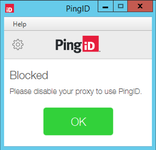
Pair PingID Desktop app certification issue
Clients using self-signed cacerts can run in to this problem. Two options are available:
-
Workaround method: Whitelist the PingID endpoints so requests that go to *.pingone.com and *.pingidentity.com still go through the proxy, but SSL/TLS termination/decryption does not apply. This avoids the certificate issue.
-
Preferred method: A self-signed certificate should be added manually by the administrator. Because the bundled JavaFX app uses its own JRE with its own cacerts, other cacerts like Windows are not acceptable, and an error might be received.